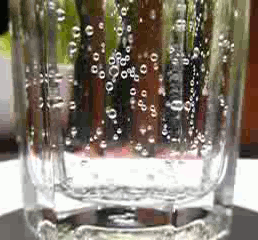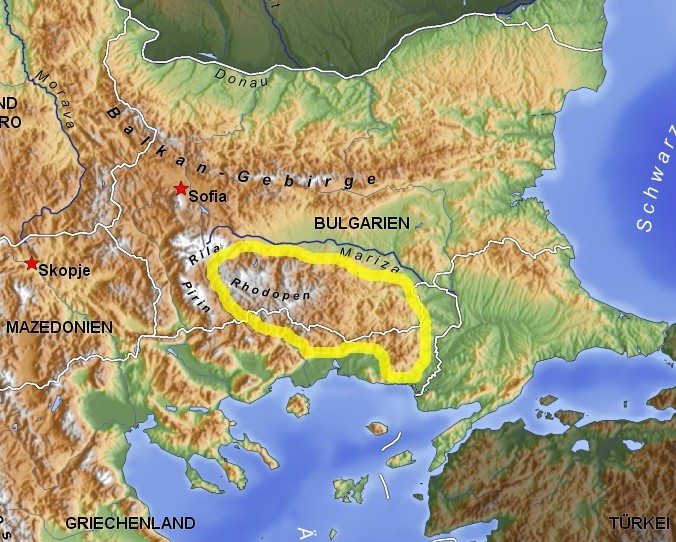|
Soda Water
Carbonated water (also known as soda water, sparkling water, fizzy water, club soda, water with gas, in many places as mineral water, or especially in the United States as seltzer or seltzer water) is water containing dissolved carbon dioxide gas, either artificially injected under pressure or occurring due to natural geological processes. Carbonation causes small bubbles to form, giving the water an effervescent quality. Common forms include sparkling natural mineral water, club soda, and commercially-produced sparkling water. Club soda and sparkling mineral water and some other sparkling waters contain added or dissolved minerals such as potassium bicarbonate, sodium bicarbonate, sodium citrate, or potassium sulfate. These occur naturally in some mineral waters but are also commonly added artificially to manufactured waters to mimic a natural flavor profile and offset the acidity of introducing carbon dioxide gas. Various carbonated waters are sold in bottles and cans, with some ... [...More Info...] [...Related Items...] OR: [Wikipedia] [Google] [Baidu] |
Water
Water (chemical formula ) is an inorganic, transparent, tasteless, odorless, and nearly colorless chemical substance, which is the main constituent of Earth's hydrosphere and the fluids of all known living organisms (in which it acts as a solvent). It is vital for all known forms of life, despite not providing food, energy or organic micronutrients. Its chemical formula, H2O, indicates that each of its molecules contains one oxygen and two hydrogen atoms, connected by covalent bonds. The hydrogen atoms are attached to the oxygen atom at an angle of 104.45°. "Water" is also the name of the liquid state of H2O at standard temperature and pressure. A number of natural states of water exist. It forms precipitation in the form of rain and aerosols in the form of fog. Clouds consist of suspended droplets of water and ice, its solid state. When finely divided, crystalline ice may precipitate in the form of snow. The gaseous state of water is steam or water vapor. Water co ... [...More Info...] [...Related Items...] OR: [Wikipedia] [Google] [Baidu] |
Thomas Henry (apothecary)
Thomas Henry (26 October 1734 – 18 June 1816) was a surgeon and apothecary. He was a Fellow of the Royal Society of London, and also the father of William Henry, the chemist who formulated Henry's Law. Background Henry was born in Wrexham, Wales training as a surgeon-apothecary in that town. He later moved to Manchester in England. Career He invented a process for preparing magnesia alba in 1771 and became known as "Magnesia" Henry. He was a founder and afterwards president of the Manchester Literary and Philosophical Society. In 1776, Thomas Henry speculated tongue in cheek that Joseph Priestley’s newly discovered dephlogisticated air (now called oxygen) might become “as fashionable as French wine at the fashionable taverns”. He did not expect, however, that tavern goers would “relish calling for a bottle of Air, instead of Claret”. After Priestley's publication of a method to make carbonated water, Henry manufactured "artificial Pyrmont and Seltzer waters" fo ... [...More Info...] [...Related Items...] OR: [Wikipedia] [Google] [Baidu] |
Rhodope Mountains
The Rhodopes (; bg, Родопи, ; el, Ροδόπη, ''Rodopi''; tr, Rodoplar) are a mountain range in Southeastern Europe, and the largest by area in Bulgaria, with over 83% of its area in the southern part of the country and the remainder in Greece. Golyam Perelik is its highest peak at . The mountain range gives its name to the terrestrial ecoregion Rodope montane mixed forests that belongs in the temperate broadleaf and mixed forests biome and the Palearctic realm. The region is particularly notable for its karst areas with their deep river gorges, large caves and specific sculptured forms, such as the Trigrad Gorge. A significant part of Bulgaria's hydropower resources are located in the western areas of the range. There are a number of hydro-cascades and dams used for electricity production, irrigation, and as tourist destinations. In Greece, there are also the hydroelectric power plants of Thisavros and Platanovrysi. The Rhodopes have a rich cultural heritage including a ... [...More Info...] [...Related Items...] OR: [Wikipedia] [Google] [Baidu] |
Artesian Well
An artesian aquifer is a confined aquifer containing groundwater under positive pressure. An artesian aquifer has trapped water, surrounded by layers of impermeable rock or clay, which apply positive pressure to the water contained within the aquifer. If a well were to be sunk into an artesian aquifer, water in the well-pipe would rise to a height corresponding to the point where hydrostatic equilibrium is reached. A well drilled into such an aquifer is called an ''artesian well''. If water reaches the ground surface under the natural pressure of the aquifer, the well is termed a ''flowing artesian well''. Fossil water aquifers can also be artesian if they are under sufficient pressure from the surrounding rocks, similar to how many newly tapped oil wells are pressurized. From the previous statement, it can be inferred that not all aquifers are artesian (i.e., water table aquifers occur where the groundwater level at the top of the aquifer is at equilibrium with atmospher ... [...More Info...] [...Related Items...] OR: [Wikipedia] [Google] [Baidu] |
Disodium Phosphate
Disodium phosphate (DSP), or disodium hydrogen phosphate, or sodium phosphate dibasic, is the inorganic compound with the formula Na2HPO4. It is one of several sodium phosphates. The salt is known in anhydrous form as well as forms with 2, 7, 8, and 12 hydrates. All are water-soluble white powders; the anhydrous salt being hygroscopic. The pH of disodium hydrogen phosphate water solution is between 8.0 and 11.0, meaning it is moderately basic: :HPO42− + H2O H2PO4− + OH− Production and reactions It can be generated by neutralization of phosphoric acid with sodium hydroxide: :H3PO4 + 2 NaOH → Na2HPO4 + 2 H2O Industrially It is prepared in a two-step process by treating dicalcium phosphate with sodium bisulfate, which precipitates calcium sulfate:Klaus Schrödter, Gerhard Bettermann, Thomas Staffel, Friedrich Wahl, Thomas Klein, Thomas Hofmann "Phosphoric Acid and Phosphates" in ''Ullmann’s Encyclopedia of Industrial Chemistry'' 2008, Wiley-VCH, Weinhei ... [...More Info...] [...Related Items...] OR: [Wikipedia] [Google] [Baidu] |
Potassium Citrate
Potassium citrate (also known as tripotassium citrate) is a potassium salt of citric acid with the molecular formula K3C6H5O7. It is a white, hygroscopic crystalline powder. It is odorless with a saline taste. It contains 38.28% potassium by mass. In the monohydrate form, it is highly hygroscopic and deliquescent. As a food additive, potassium citrate is used to regulate acidity, and is known as E number E332. Medicinally, it may be used to control kidney stones derived from uric acid or cystine. In 2020, it was the 297th most commonly prescribed medication in the United States, with more than 1million prescriptions. Synthesis Potassium citrate can be synthesized by the neutralization of citric acid which is achieved by the addition of potassium bicarbonate, potassium carbonate or potassium hydroxide to it. The solution can then be filtered and the solvent can be evaporated till granulation. Uses Potassium citrate is rapidly absorbed when given by mouth, and is excreted in the ... [...More Info...] [...Related Items...] OR: [Wikipedia] [Google] [Baidu] |
Sodium Chloride
Sodium chloride , commonly known as salt (although sea salt also contains other chemical salts), is an ionic compound with the chemical formula NaCl, representing a 1:1 ratio of sodium and chloride ions. With molar masses of 22.99 and 35.45 g/mol respectively, 100 g of NaCl contains 39.34 g Na and 60.66 g Cl. Sodium chloride is the salt most responsible for the salinity of seawater and of the extracellular fluid of many multicellular organisms. In its edible form, salt (also known as ''table salt'') is commonly used as a condiment and food preservative. Large quantities of sodium chloride are used in many industrial processes, and it is a major source of sodium and chlorine compounds used as feedstocks for further chemical syntheses. Another major application of sodium chloride is de-icing of roadways in sub-freezing weather. Uses In addition to the familiar domestic uses of salt, more dominant applications of the approximately 250 million tonnes per year production (2008 ... [...More Info...] [...Related Items...] OR: [Wikipedia] [Google] [Baidu] |
Copley Medal
The Copley Medal is an award given by the Royal Society, for "outstanding achievements in research in any branch of science". It alternates between the physical sciences or mathematics and the biological sciences. Given every year, the medal is the oldest Royal Society medal awarded and the oldest surviving scientific award in the world, having first been given in 1731 to Stephen Gray (scientist), Stephen Gray, for "his new Electrical Experiments: – as an encouragement to him for the readiness he has always shown in obliging the Society with his discoveries and improvements in this part of Natural Knowledge". __TOC__ History The medal was created following a donation of Pound sterling, £100 to be used for carrying out experiments by Sir Godfrey Copley, 2nd Baronet, Sir Godfrey Copley, for which the interest on the amount was used for several years. The conditions for the medal have been changed several times; in 1736, it was suggested that "a medal or other honorary prize s ... [...More Info...] [...Related Items...] OR: [Wikipedia] [Google] [Baidu] |
Royal Society
The Royal Society, formally The Royal Society of London for Improving Natural Knowledge, is a learned society and the United Kingdom's national academy of sciences. The society fulfils a number of roles: promoting science and its benefits, recognising excellence in science, supporting outstanding science, providing scientific advice for policy, education and public engagement and fostering international and global co-operation. Founded on 28 November 1660, it was granted a royal charter by King Charles II as The Royal Society and is the oldest continuously existing scientific academy in the world. The society is governed by its Council, which is chaired by the Society's President, according to a set of statutes and standing orders. The members of Council and the President are elected from and by its Fellows, the basic members of the society, who are themselves elected by existing Fellows. , there are about 1,700 fellows, allowed to use the postnominal title FRS (Fellow of the ... [...More Info...] [...Related Items...] OR: [Wikipedia] [Google] [Baidu] |
Schweppes
Schweppes (, ) is a beverage brand that originated in the Republic of Geneva; it is made, bottled and distributed worldwide by multiple international conglomerates, depending on licensing and region, that manufacture and sell soft drinks. Schweppes was one of the earliest forms of a soft drink, originally being regular soda water created in 1783. Today, various drinks other than soda water bear the Schweppes brand name, including various types of lemonade and ginger ales. The company has held the British royal warrant since 1836 and was the official sponsor of Prince Albert's Great Exhibition in Hyde Park, London in 1851. History In the late 18th century, German-Genevan scientist Johann Jacob Schweppe developed a process to manufacture bottled carbonated mineral water based on the discoveries of English chemist Joseph Priestley. Schweppe founded the Schweppes Company in Geneva in 1783 to sell carbonated water. In 1792, he moved to London to develop the business there. In 1843 ... [...More Info...] [...Related Items...] OR: [Wikipedia] [Google] [Baidu] |




_SCHWEPPES_MINERAL-WATERS.jpg)